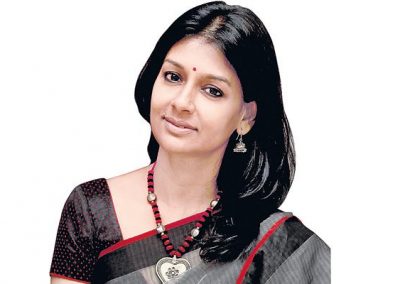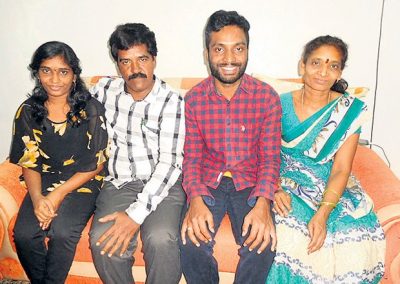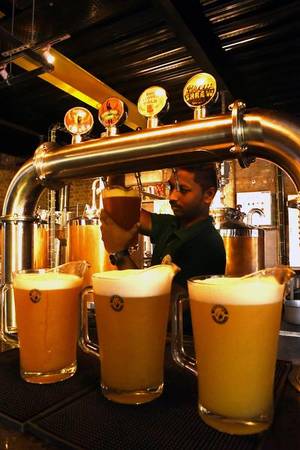We could well see 500 brewpubs pop up in the next five years
Amartya Sen, the Nobel laureate, was once told by his teacher, the great economist Joan Robinson, “The frustrating thing about India is that whatever you can rightly say about India, the opposite is also true.”
This can apply as much to India’s economy as it can to its beer consumption trends. In a country where 95% of the beer market is accounted for by lager, and 65% of that by strong beer, it seems anachronistic for scores of craft beer operations to exist.
But on a baking hot day, I’m on my way to Malanpur near Gwalior to slake my thirst at one of them, a brand called White Rhino. Ishaan Puri, a director of White Rhino, explains his choice of location: a nearby tributary of the Chambal helps supply soft water with the perfect characteristics that beer needs (Ph neutral/ low in dissolved solids/ low hardness/ low heavy metals). Added to this, being a rain-fed river, it replenishes each year, and thus has no taint or odour.
The white rhino, also the second largest land mammal after the elephant, was on the verge of being poached to extinction, and Puri felt that, like the animal, their venture too was rare in its unwillingness to cut corners. The careful attention to the water source was my first clue to this testament, and my second was during our first halt at the brewery, the air-conditioned malt room that stores Pilsner malt used in both their Munich-style lager and in their Belgian witbier, which also uses imported wheat malt, and some locally sourced rolled wheat.
The word craft is much bandied about. I ask Puri, whose venture is some 18 months old now, how he’d define it. He replies the best way he can, by ushering me into their brew house, where a fresh batch of IPA (India pale ale) lies dormant in the tanks. A spigot in the side gives me a sample, and as I taste it, I remark with surprise that the taste is different from what I had tasted at The Beer Café in Gurugram some months ago.
Flavour and variety
Craft isn’t necessarily about consistency, Puri explains. Apart from the focus on quality and the attention to detail, the carefully sourced choice of water, the high quality malt — and Felix, the German brew master, literally wears his passion for alcohol on his sleeve (he has the formula for alcoholic fermentation tattooed on his arm) — craft is also about flavour and variety. The current batch of IPA being brewed up for the domestic market is going to be akin in its IBU profile (International Bitterness Units scale) to the export variant that is shipped to the U.K. and Nepal. Full circle for IPA, given that this is a style of beer originally thought to have been developed in the U.K., to slake the thirst of the garrisons in British-ruled India. White Rhino offers its beer both in kegs and in bottles, and its pricing is premium. It’s clearly a model that’s working; Puri indicates that he’s operating at nearly his installed capacity and expects to break even in another 12-15 months. His introduction of the IPA to the domestic market is potentially risky, due to its markedly bitter taste, but he says, “The IPA is more about educating consumers and building a community, which is very important for craft beer.”
New wave of entrepreneurs
An Economics graduate, Puri was drawn by a love of beer, and no doubt itchy entrepreneurial feet, to take a course in brewing in the U.K. And his technocrat background is quite representative of the new wave of entrepreneurs who inhabit micro segments of the Indian beer industry, pockets that are still largely ignored by the mass marketers.
The craft beer wave truly began nine years ago with Indian microbreweries making and serving fresh beer on-site in what we call brewpubs. Prateek Chaturvedi, a co-founder of Doolally (although no longer part of the core team), met me back in 2006 when he was struggling to get funding and helping craft the nation’s first legislations to deal with brewpubs. Chaturvedi and his co-founders were Singapore-based corporate executives who were so fascinated by the variety and quality of beer they drank at the iconic Brewerkz in Clarke Quay that they decided to relocate to India to replicate the experience.
Although Doolally narrowly missed the bus to be anointed as India’s first brew pub, the honour taken away by Gurugram’s Howzzat, they helped start a revolution, which has now become 100-plus brewpubs across the country, and still growing.
Until the brewpubs came, draught beer was not very popular here, perceived as being “cheap” rather than fresh or flavourful. Brewpubs did a lot to change that perception. Innovation until then had been for the most part fallen short, except for a couple of short-lived attempts by SABMiller, first with Hayward’s Black Label, India’s first homegrown stout beer, and then with Indus Pride, a spiced lager.
The Biere Club in Bengaluru | Photo Credit: K. MURALI KUMAR
Brewpubs were still constrained by the fact that you could only drink their beer within their premises. Doolally was again at the forefront of the next wave of change, when the Maharashtra government allowed brewpubs to start “kegging” or selling in casks to other bars and restaurants, a move that prompted Doolally, for one, to open its first (of many) taprooms in Mumbai’s Bandra, where it could serve fresh beer made in its brewpub in Pune.
Of course, you don’t need just a brewpub to make and sell craft beer. In 2011, Mumbai’s Gateway Brewing came up. Co-founded by Navin Mittal, its roots lay in his experiments with home brewing for five years, and a blog called www.indianbeergeek.com that enabled him to get in touch with fellow beer lovers Rahul and Krishna. The three of them, tired of grumbling about the lack of character and variety in most commercially available beers in India, decided to start their own microbrewery on the outskirts of Mumbai.
Mittal hopes his beer will form a ‘gateway’ for Indians to discover the exciting and vibrant world of craft beer, which he defines as having “a focus on taste and not on making the least flavourful, cheapest drink that will appeal to no one and offend no one.”
Gateway’s current range of beers includes a wheat beer called White Zen, Doppelganger (a Dunkelweizen), Citra IPA, Side Car (a cider) and Cream Stout. Some of these are available on tap at bars across Mumbai, whereas others are only available at Gateway’s Taproom in Bandra. The taproom marked the next stage in Gateway’s evolution and perhaps bottled beer is not too far away.
Hobby turned profession
Ajay Nagarajan was living in Texas, a technology professional with a Master’s in electronics engineering. Along the way, he’d taken to home brewing, a fairly popular pastime there and something he’d come to enjoy. His hobby became a profession when he enrolled in one of America’s oldest brewing schools, The Siebel Institute of Technology in Chicago, to learn the art and business of brewing. He returned to India in 2011, and with like-minded partners set up Windmills Craftworks in Bengaluru’s Whitefield area.
Windmills, along with Arbor Brewing and Toit, has come to be regarded as one of the stand-out brewpubs in the city’s now crowded brewing landscape.
Obviously, consumers love all this action, and when I speak to Anasua Saha in Bengaluru, a frequent visitor to brewpubs, she says what’s exciting is “to get the small samples of the different beers because it helps choice and also allows one to try the different varieties one wouldn’t otherwise.” She loves the fact that several brewpubs also produce special craft beers for different occasions, and has fond memories of the Apple Pie beer produced by Mumbai’s Barking Deer (now taken over by Thirsty Beer).
So how ‘Indian’ is all this craft beer? After all, it relies heavily on imported ingredients, equipment and know-how. It’s true that it is still a fledgling industry, but one would hope that the next stage of growth will include more local sourcing, without compromising quality. Apart from reducing its carbon footprint, one can then also expect lower prices, and then hopefully an expansion of market. Hops and malt (whether regular or speciality) are the primary ingredients for beer, and hops are still imported, as the limited stuff grown in India in the Himalayan foothills are of inferior quality.
Nagarajan at Windmills imports all his malt; he says malting is a specialised skill that’s been perfected over hundreds of years in the West, and there’s little point in reinventing the wheel. Mittal at Gateway Brewing, however, has always used Indian base malts, but is not dismayed by the overwhelming use of imported malt by most craft breweries, and says that what’s important is that these beers “are made in India by passionate brewers who get inspired by craft beers across the world and put their own spin on it.”
Very Indian and classic
What is definitely a trend in craft beer is the growing use of Indian ingredients and adaptations of classic styles for the Indian palate, whether it is the use of grated, roasted, dried coconut in the mash for Windmill’s coconut porter or their Alphonso Mango Pale Ale. Gateway too has some interesting adaptations, including their Kaapi Stout, Guava Ale, and most recently their Nimbu Pani Ale, which is soured using Yakult instead of a sour pitch of yeast, making it even more Indian. And although it’s unlikely that India is going to develop a new, unique style of beer any time soon, as Nagarajan says, one could see the German Hefeweizen becoming a uniquely Indian beer, as it’s the most popular style in India.
Brewmaster Vidya Kubher at Geist Beer Factory in Bengaluru | Photo Credit: Sudhakara Jain
It has now also become a trend, starting with Bira, and moving on to new entrants Thirsty and Happy Head, to contract brew overseas and ship it back home. Some of you will remember a pioneer of this practice, a Bengaluru-based company that contract-brewed in Belgium and shipped back to India in stubby bottles bearing the brand name Geist (geist in German means the spirit of an individual or group). Geist was clearly ahead of its times, nearly 10 years ago, and the venture was short-lived. Geist kept its brewing passion alive through brewpubs, but its heart clearly was in packaged beer, and the company’s second coming now is a craft brewery near Bengaluru that produces an exciting range of beers supplied in kegs to Bengaluru’s bars, of which my favourite is the KamaCitra IPA.
Beer with millets
As Narayan Manepally, one of Geist’s founders, says, “We always believed in this category and that this is the beer India will drink in the long term. We saw it before many others and decided that despite how hard things are when you are pioneering a path, we won’t give up.” Manepally foresees the emergence of a distinctively Indian beer that uses grains like millets. The pace of change in the last few years has been heartening and as I write this, I read that the DelhiDevelopment Authority is helping clear the final obstacles in setting up microbreweries. This is likely to see some 80-odd brewpubs coming up in the capital alone in the next few years. And I don’t have to be an optimist to say that we will see nearly 500 brewpubs across the country in the next five years.
Meanwhile, brewpubs like Windmills are spreading their wings, with a brewery coming up in Goa and more brew pubs planned across cities, as well as one in Texas. As regulations ease, we are also likely to see more State governments allowing kegging and permitting brewpubs to package and sell their beer in bottles or in takeaway ‘growlers’ (a handy jug used to transport draft beer). Already, Windmills in Goa plans to can its beer plus supply kegs to Goa’s hotels and bars. Beer pub chains are likely to emerge. The first steps are being taken by outlets like Toit, Arbor and Windmills, all of which have expanded outside their home towns. As Manepally says, craft beers are in ‘fast ferment’ mode. Let’s drink to that.
The Mentor
Oliver Schauf of Doolally
Oliver Schauf
Schauf was drawn to India 10 years ago by his love for beer and travel. As one of the pioneering brew masters in India, he has mentored several more and been a source of inspiration for aspiring brew masters across the country. He believes “there’s lots of talent in Indian craft brewing. Brewers here are very enthusiastic about their work, and their enthusiasm is often backed up by some solid formal education, and we are going to see some truly great beers in the years to come.”
The Evangelist
John Eapen of Friends of Froth
John Eapen
Eapen runs Friends of Froth, India’s most popular online community for lovers of craft beer. “There are dedicated craft beer aficionados who are taking a serious interest in beer and there is a growing awareness about craft beer across the country. Craft is here to stay,” he says. “But brands that are only revenue focused and don’t pay attention to quality and consistency will fall by the wayside as consumers begin to demand better quality beers and develop palates to appreciate a plethora of styles.”








